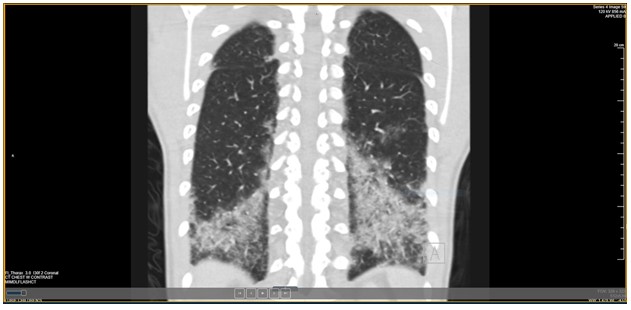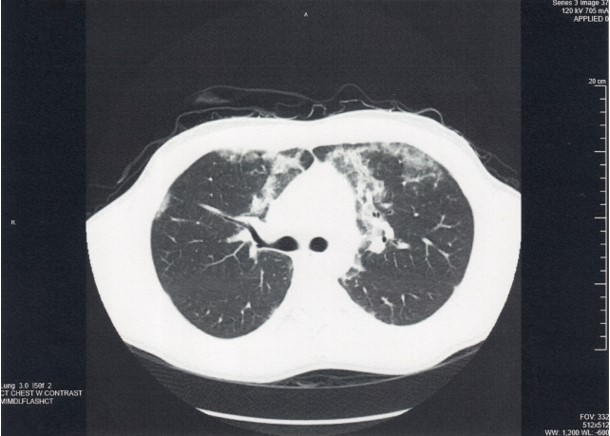Mind the Gap
Classic CT chest findings of an adolescent with EVALI
Zachary Johnson, DO, Ann & Robert Lurie Children's Hospital, Northwestern University
Terri Laguna, MD, Ann & Robert Lurie Children's Hospital, Northwestern University
Case
A 14-year-old young man with a remote history of asthma and allergic rhinitis presented to the Emergency Room with a five-day history of cough, fever, abdominal pain and chest pain. On arrival to the emergency department he was febrile to 38.1 degrees and tachycardic to 108 breaths per minute. He was breathing 20 breaths per minute and saturating 95% on room air. He appeared comfortable and had a normal lung exam. Initial diagnostic workup included a CBC with a leukocytosis to 17.6 and 91.8% neutrophil predominance. He had elevated inflammatory markers with a CRP of 27.8 mg/dl (normal <0.8), ESR of 72 mm/hr (normal <20) and procalcitonin of 0.29 ng/ml (normal <0.1). CMP was unremarkable and NT-ProBNP was elevated at 194 pg/ml (normal <125). Initial chest x-ray showed non-specific medial and basal lung opacities. Given the abdominal pain and fever, an abdominal and pelvic CT scan was performed revealing diffuse ground glass opacification of lung bases. The patient was admitted to the hospital, and treated with azithromycin and ceftriaxone. However, broad infectious workup was negative. COVID testing was negative and he did not meet the criteria for MIS-C.
To better assess the entire lung fields, a chest CT scan was performed and is shown below.
Question
What key information is likely to be obtained on detailed social history?
- He adopted a pet parakeet one month ago
- He has a longstanding history of vaping THC and tobacco products.
- He just returned from a vacation exploring caves in Lake of the Ozarks.
- He has a history of ingesting undercooked pork.
B. He has a longstanding history of vaping THC and tobacco products
Discussion
This CT scan demonstrates ground glass opacification with relative sparing of the subpleural spaces. Of the answer choices, this is most consistent with e-cigarette or vaping product use associated lung injury (EVALI). The patient acknowledges frequent and chronic vaping product use. He started vaping when he was nine years old and continues to vape both THC oils and tobacco products daily. During his hospitalization, the patient required transfer to the PICU for bilevel noninvasive respiratory support. Additionally, his course was complicated by pneumomediastinum, bilateral pneumothoraces and subcutaneous emphysema, all managed medically. He responded well to a course of systemic steroids and was discharged home on room air with close pulmonary outpatient follow-up.
Pet parakeets may be associated with an acute hypersensitivity pneumonitis. Hypersensitivity pneumonitis presents radiologically with upper and middle lobe predominant ground-glass opacities with possible mosaic attenuation and poorly defined centrilobular nodules (Answer A is incorrect). Exploring caves may raise suspicion for acute histoplasmosis. Typically, chest imaging will identify consolidation similar to bacterial pneumonia and may show healing histoplasmomas or nodules with central calcification (Answer C is incorrect). Ingestion of undercooked pork is associated with pulmonary toxoplasmosis. Pulmonary toxoplasmosis can manifest as interstitial pneumonia/diffuse alveolar damage or necrotizing pneumonia (Answer D is incorrect). This is typically seen in immunocompromised hosts. Subpleural sparing is not classically associated with any of the above conditions.
Use of e-cigarettes in the U.S. has increased from approximately 7 million users in 2011 to 41 million users in 2018. Users of e-cigarettes can inhale high concentrations of propylene glycol, glycerol, volatile organic compounds, heavy metals and ultrafine particulates. The first outbreak of EVALI was first reported in August of 2019 in Wisconsin. From August 2019 to February 2020 there were 2807 confirmed cases and 68 deaths. 82% of patients hospitalized with EVALI reported use of a product with THC and vitamin E acetate. The CDC has since published a case definition including the following:
- Use of an e-cigarette within 90 days before symptom onset
- Presence of pulmonary infiltrate such as opacities on plain film chest radiograph or ground glass opacities on chest CT
- No evidence of infection identified via culture or PCR
- No alternative plausible diagnoses
Patients with EVALI often have gradual onset of cough, chest pain, shortness of breath, abdominal pain, nausea, vomiting, diarrhea, fatigue, fever and tachycardia. Laboratory results often demonstrate leukocytosis with neutrophil predominance, elevated inflammatory markers, and elevated transaminases.
Chest imaging, apart from subpleural sparing, is often non-specific. Studies have shown that most patients have chest CT imaging with ground-glass opacification (96-100%). Septal thickening can be seen in 14-29%, consolidation in 42-64%, and subpleural sparing in 45-79% of patients.
The primary treatments may include antibiotics to treat superimposed infections and corticosteroids to treat lung inflammation. However, there is no conclusive studies to date demonstrating steroid efficacy. Long-term effects of EVALI on lung health are not yet known.
References
-
Artunduaga M, Rao D, Friedman J, Kwon JK, Pfeifer CM, Dettori A, Winant AJ, Lee EY. Pediatric Chest Radiographic and CT Findings of Electronic Cigarette or Vaping Product Use-associated Lung Injury (EVALI). Radiology. 2020 May;295(2):430-438. doi: 10.1148/radiol.2020192778. Epub 2020 Mar 3. PMID: 32125258.
-
Panse PM, Feller FF, Butt YM, Smith ML, Larsen BT, Tazelaar HD, Harvin HJ, Gotway MB. Radiologic and Pathologic Correlation in EVALI. AJR Am J Roentgenol. 2020 Nov;215(5):1057-1064. doi: 10.2214/AJR.20.22836. Epub 2020 Sep 2. PMID: 32877245.
-
Shinbashi M, Rubin BK. Electronic cigarettes and e-cigarette/vaping product use associated lung injury (EVALI). Paediatr Respir Rev. 2020 Nov;36:87-91. doi: 10.1016/j.prrv.2020.06.003. Epub 2020 Jun 11. PMID: 32653465.
-
Vasakova M, Morell F, Walsh S, Leslie K, Raghu G. Hypersensitivity Pneumonitis: Perspectives in Diagnosis and Management. Am J Respir Crit Care Med. 2017 Sep 15;196(6):680-689. doi: 10.1164/rccm.201611-2201PP. PMID: 28598197.





